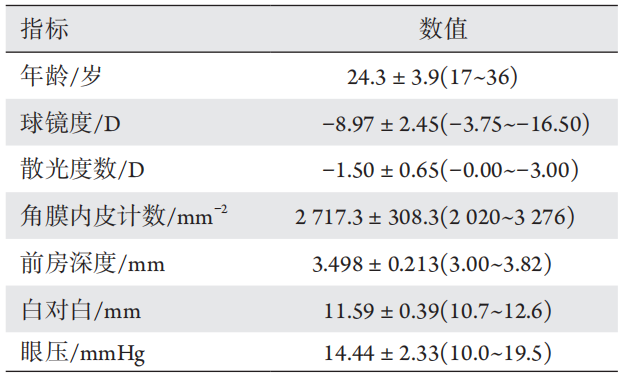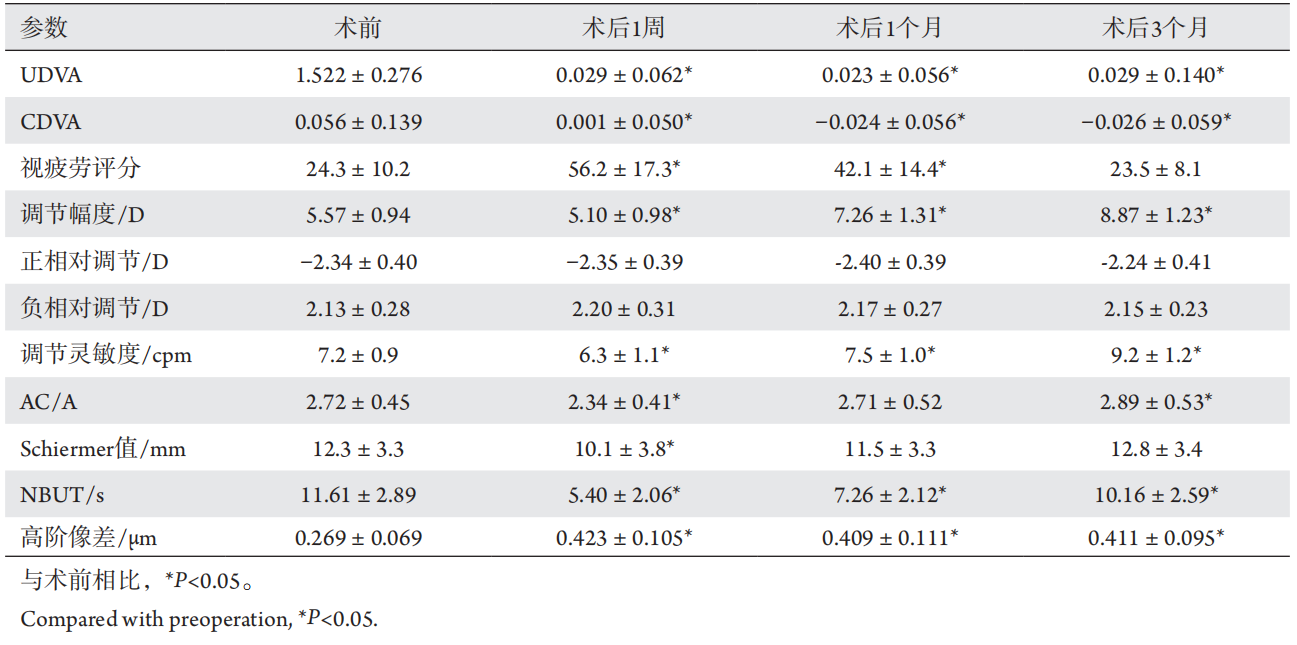1、Choi JH, Lim DH, Nam SW, et al. Ten-year clinical outcomes after
implantation of a posterior chamber phakic intraocular lens for
myopia[ J]. J Cataract Refract Surg, 2019, 45(11): 1555-1561.Choi JH, Lim DH, Nam SW, et al. Ten-year clinical outcomes after
implantation of a posterior chamber phakic intraocular lens for
myopia[ J]. J Cataract Refract Surg, 2019, 45(11): 1555-1561.
2、Wei R , Li M, Niu L, et al. Comparison of visual outcomes after
non-toric and toric implantable collamer lens V4c for myopia and
astigmatism[ J]. Acta Ophthalmol, 2021, 99(5): 511-518.Wei R , Li M, Niu L, et al. Comparison of visual outcomes after
non-toric and toric implantable collamer lens V4c for myopia and
astigmatism[ J]. Acta Ophthalmol, 2021, 99(5): 511-518.
3、Han T, Chen X, Xu Y, et al. Refractive outcomes of implantable
collamer lens implantation in 1212 eyes with suboptimal corrected
distance vision acuity[ J]. Curr Eye Res, 2022. [Epub ahead of print].
doi: 10.1080/02713683.2022.2094418.Han T, Chen X, Xu Y, et al. Refractive outcomes of implantable
collamer lens implantation in 1212 eyes with suboptimal corrected
distance vision acuity[ J]. Curr Eye Res, 2022. [Epub ahead of print].
doi: 10.1080/02713683.2022.2094418.
4、Sivaraman V, Price HC, Hussaindeen JR, et al. Near work-induced
transient myopia and accommodation function before and after laser-
assisted in situ keratomileusis surgery[ J]. Indian J Ophthalmol, 2021,
69(7): 1707-1711.Sivaraman V, Price HC, Hussaindeen JR, et al. Near work-induced
transient myopia and accommodation function before and after laser-
assisted in situ keratomileusis surgery[ J]. Indian J Ophthalmol, 2021,
69(7): 1707-1711.
5、林艳艳, 邓如芝, 李志华, 等. 视疲劳量表的制订及评价[ J]. 中华
眼科杂志, 2021, 57(4): 284-291.
LIN Yanyan, DENG Ruzhi, LI Zhihua, et al. A new valid and reliable
questionnaire of asthenopia: development and evaluation[ J]. Chinese
Journal of Ophthalmology, 2021, 57(4): 284-291.林艳艳, 邓如芝, 李志华, 等. 视疲劳量表的制订及评价[ J]. 中华
眼科杂志, 2021, 57(4): 284-291.
LIN Yanyan, DENG Ruzhi, LI Zhihua, et al. A new valid and reliable
questionnaire of asthenopia: development and evaluation[ J]. Chinese
Journal of Ophthalmology, 2021, 57(4): 284-291.
6、中华医学会眼科学分会眼视光学组. 视疲劳诊疗专家共识
(2014年)[ J]. 中华眼视光学与视觉科学杂志, 2014, 16(7): 385-387.
Ophthalmology Group, Ophthalmology Society, Chinese Medical
Association. Expert consensus for the diagnosis and treatment of
asthenopia (2014)[ J]. Chinese Journal of Optometry and Vision
Science, 2014, 16(7): 385-387.中华医学会眼科学分会眼视光学组. 视疲劳诊疗专家共识
(2014年)[ J]. 中华眼视光学与视觉科学杂志, 2014, 16(7): 385-387.
Ophthalmology Group, Ophthalmology Society, Chinese Medical
Association. Expert consensus for the diagnosis and treatment of
asthenopia (2014)[ J]. Chinese Journal of Optometry and Vision
Science, 2014, 16(7): 385-387.
7、邓国涛, 贡雅洁. Lasik术后眼调节状态的改变及其与视疲劳的
关系[ J]. 中华眼视光学与视觉科学杂志, 2012, 14(3): 169-172.
DENG Guotao, GONG Yajie. Changes in accommodation status
after LASIK and its relationship with asthenopia[ J]. Chinese
Journal of Optometry Ophthalmology and Visual Science, 2012,
14(3): 169-172.邓国涛, 贡雅洁. Lasik术后眼调节状态的改变及其与视疲劳的
关系[ J]. 中华眼视光学与视觉科学杂志, 2012, 14(3): 169-172.
DENG Guotao, GONG Yajie. Changes in accommodation status
after LASIK and its relationship with asthenopia[ J]. Chinese
Journal of Optometry Ophthalmology and Visual Science, 2012,
14(3): 169-172.
8、周水莲, 许小毛, 曾爱兰, 等. 七叶洋地黄双苷滴眼液治疗fs-lasik
术后视疲劳的疗效观察[ J]. 江西医药, 2021, 56(2): 139-142.
ZHOU Shuilian, XU Xiaomao, ZENG Ailan, et al. The clinical effect
on the efficacy of esculin and digitalisglycosides eye drops in treating
asthenopia in patients after FSLASIK[ J]. Jiangxi Medical Journal, 2021,
56(2): 139-142.周水莲, 许小毛, 曾爱兰, 等. 七叶洋地黄双苷滴眼液治疗fs-lasik
术后视疲劳的疗效观察[ J]. 江西医药, 2021, 56(2): 139-142.
ZHOU Shuilian, XU Xiaomao, ZENG Ailan, et al. The clinical effect
on the efficacy of esculin and digitalisglycosides eye drops in treating
asthenopia in patients after FSLASIK[ J]. Jiangxi Medical Journal, 2021,
56(2): 139-142.
9、付晶, 王晓贞, 王宁利, 等. 有晶状体眼后房型人工晶状体植入术
后调节相关参数的变化[ J]. 中华眼科杂志, 2013, 49(7): 633-636.
FU Jing, WANG Xiaozhen, WANG Ningli, et al. Accommodation
parameters after phakic posterior chamber implantable contact lens
implantation[ J]. Chinese Journal of Ophthalmology, 2013, 49(7):
633-636.付晶, 王晓贞, 王宁利, 等. 有晶状体眼后房型人工晶状体植入术
后调节相关参数的变化[ J]. 中华眼科杂志, 2013, 49(7): 633-636.
FU Jing, WANG Xiaozhen, WANG Ningli, et al. Accommodation
parameters after phakic posterior chamber implantable contact lens
implantation[ J]. Chinese Journal of Ophthalmology, 2013, 49(7):
633-636.
10、马可, 王琳, 邱乐梅, 等. 高度近视眼有晶状体眼后房型人工晶状
体植入术后调节功能变化[ J]. 中华眼视光学与视觉科学杂志,
2015, 17(8): 471-473.
MA Ke, WANG Lin, QIU Lemei, et al. The effect of phakic posterior
chamber implantable collamer lens implantation on accommodative
functions[ J]. Chinese Journal of Optometry and Vision Science, 2015,
17(8): 471-473.马可, 王琳, 邱乐梅, 等. 高度近视眼有晶状体眼后房型人工晶状
体植入术后调节功能变化[ J]. 中华眼视光学与视觉科学杂志,
2015, 17(8): 471-473.
MA Ke, WANG Lin, QIU Lemei, et al. The effect of phakic posterior
chamber implantable collamer lens implantation on accommodative
functions[ J]. Chinese Journal of Optometry and Vision Science, 2015,
17(8): 471-473.
11、Chen M, Long Q, Gu H, et al. Accommodation changes after visian
implantable collamer lens with central hole for high myopia: A
STROBE-compliant article[ J]. Medicine (Baltimore), 2019, 98(28):
e16434.Chen M, Long Q, Gu H, et al. Accommodation changes after visian
implantable collamer lens with central hole for high myopia: A
STROBE-compliant article[ J]. Medicine (Baltimore), 2019, 98(28):
e16434.
12、Li L, Zhang B, Wang Z. Comparison of accommodation and
accommodative micro-fluctuation after implantable collamer lens and
LASIK surgery for myopia[ J]. BMC Ophthalmol, 2022, 22(1): 8.Li L, Zhang B, Wang Z. Comparison of accommodation and
accommodative micro-fluctuation after implantable collamer lens and
LASIK surgery for myopia[ J]. BMC Ophthalmol, 2022, 22(1): 8.
13、Gyldenkerne A , A agaard N, Jakobsen M, et al. Changes inGyldenkerne A , A agaard N, Jakobsen M, et al. Changes in
14、Sivaraman V, Price HC, Hussaindeen JR, et al. Nearwork-induced
transient myopia and accommodation function before and after laser-
assisted in situ keratomileusis surgery[ J]. Indian J Ophthalmol, 2021,
69(7): 1707-1711Sivaraman V, Price HC, Hussaindeen JR, et al. Nearwork-induced
transient myopia and accommodation function before and after laser-
assisted in situ keratomileusis surgery[ J]. Indian J Ophthalmol, 2021,
69(7): 1707-1711
15、Karimian F, Baradaran-Rafii A, Bagheri A, et al. Accommodative
changes after photorefractive keratectomy in myopic eyes[ J]. Optom
Vis Sci, 2010, 87(11): 833-838.Karimian F, Baradaran-Rafii A, Bagheri A, et al. Accommodative
changes after photorefractive keratectomy in myopic eyes[ J]. Optom
Vis Sci, 2010, 87(11): 833-838.
16、周少博, 郭海科, 谭娟, 等. 近视眼lasik术后调节灵洁度变化与视
觉疲劳的关系[ J]. 眼科新进展, 2012, 32(3): 286-288.
ZHOU Shaobo, GUO Haike, TAN Juan, et al. Changes of accommodative
facility in myopia after LASIK and its relation with asthenopia[J]. Recent
Advances in Ophthalmology, 2012, 32(3): 286-288.周少博, 郭海科, 谭娟, 等. 近视眼lasik术后调节灵洁度变化与视
觉疲劳的关系[ J]. 眼科新进展, 2012, 32(3): 286-288.
ZHOU Shaobo, GUO Haike, TAN Juan, et al. Changes of accommodative
facility in myopia after LASIK and its relation with asthenopia[J]. Recent
Advances in Ophthalmology, 2012, 32(3): 286-288.
17、Iribarren R, Fornaciari A, Hung GK. Effect of cumulative nearwork
on accommodative facility and asthenopia[ J]. Int Ophthalmol, 2001,
24(4): 205-212.Iribarren R, Fornaciari A, Hung GK. Effect of cumulative nearwork
on accommodative facility and asthenopia[ J]. Int Ophthalmol, 2001,
24(4): 205-212.
18、罗启惠, 刘波, 陈利, 等. 有晶状体眼后房型人工晶状体植入术对
高度近视眼调节功能影响的临床观察[ J]. 中华眼科杂志, 2021,
57(2): 113-121.
LUO Qihui, LIU Bo, CHEN Li, et al. The effects of posterior chamber
intraocular lens implantation on accommodative function in high
myopia[ J]. Chinese Journal of Ophthalmology, 2021, 57(2): 113-121.罗启惠, 刘波, 陈利, 等. 有晶状体眼后房型人工晶状体植入术对
高度近视眼调节功能影响的临床观察[ J]. 中华眼科杂志, 2021,
57(2): 113-121.
LUO Qihui, LIU Bo, CHEN Li, et al. The effects of posterior chamber
intraocular lens implantation on accommodative function in high
myopia[ J]. Chinese Journal of Ophthalmology, 2021, 57(2): 113-121.
19、Toda I. Dry eye after LASIK[ J]. Invest Ophthalmol Vis Sci, 2018,
59(14): 109-115.Toda I. Dry eye after LASIK[ J]. Invest Ophthalmol Vis Sci, 2018,
59(14): 109-115.
20、Liu HT, Zhou Z, Luo WQ, et al. Comparison of optical quality after
implantable collamer lens implantation and wavefront-guided laser in
situ keratomileusis[ J]. Int J Ophthalmol, 2018, 11(4): 656-661.Liu HT, Zhou Z, Luo WQ, et al. Comparison of optical quality after
implantable collamer lens implantation and wavefront-guided laser in
situ keratomileusis[ J]. Int J Ophthalmol, 2018, 11(4): 656-661.





